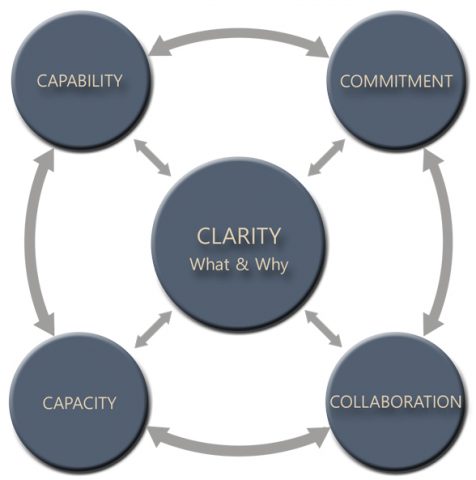5Cs – The Results Model
The five ‘C’s of the Results Model represent the five critical factors for leaders and leadership teams wishing to drive organisational performance and implement change. The model helps leaders to focus their strategic thinking, making execution more effective and results easier to obtain.
Developed from nearly 40 years of experience of working with leaders and leadership teams, the 5Cs are now used by leaders in a range of industries to facilitate planning, resolve strategic issues and review progress. If you are looking to accelerate business growth, embed change or transform culture, the 5Cs will help.

It might sound simple, but if you don’t know where you are going, how will you know when you have got there?
Clarity sits at the heart of everything that happens in organisations, but can be one of the trickiest things to deliver. Individually everyone believes that they are clear about what needs to be done, and why it is important, but rarely are these mental pictures of the world aligned. It is hard enough to align a leadership team, let alone an organisation!
‘Clarity’ is about creating a single vision, goal or direction that can be clearly explained and communicated to everyone concerned. It’s about anchoring the ‘What we need to do’ by providing ‘Why this important’ in a way that everyone involved can connect to it personally.
When we are working with leadership teams, we start by exploring gaps between what different team members believe about the ‘What & Why’, helping them to align before going on to work through how they can communicate this to engage their stakeholders.
What needs to be in place to be able to deliver on your objectives?
Capability covers a range of topics, from organisational skills and experience, through to culture, confidence and mind-set. It also looks at the physical, exploring the suitability of the environment, the organisational infrastructure and processes. Understanding how each of these needs to adapt or change to deal with where you are heading, and the implications of that change, allows leaders to focus their energy on the areas that will have the greatest impact on the result.
The organisational ability to deliver needs the right people – thinking in the right way – with the right tools, aligned across leadership, management and the workforce. Often leaders focus on developing new skills, without considering how cultural interference or the organisational processes might be driving employees back to old ways of working.
The dictionary defines commitment as “the state or quality of being dedicated to a cause, activity, etc.”
Assessing commitment for us is the use of a simple question: are you committed to the vision, strategy, objectives or goals? With one simple response; yes, or no!
Leaders are constantly being watched and evaluated by their people. They are testing to see whether leaders are committed to the cause, the activity, the vision. How you and your leadership colleagues behave will set the tone for everything else you do.
Thinking Focus works with leadership teams to create a safe environment where what commitment means can be discussed and challenged, allowing leaders to share concerns privately but speak with one voice publicly, ensuring stakeholders see engaged & committed leadership.
From motivation to influence, Collaboration is about everything involved in getting others on board and willing to help.
- Who could help achieve our goal, strategy or vision?
- Who might get in the way or slow down our progress?
These two simple questions are the starting point of collaboration. We help you to look at collaboration from different perspectives starting with the way leadership teams work together, then working through cross-functional issues to ensure a 360-degree view of who to involve and how to engage them to ensure success.
Once you have a clear view of the different people and groups that are affected by, or needed for the success you are after, Collaboration explores different ways to ensure they are involved and engaged, considering the impact you may be having on them, as well as how you might be able to help them.
Building trust, mending bridges and developing win-win strategies are just some of the areas covered under Collaboration.
How does this fit with everything else you need to achieve?
Thinking about Capacity requires leaders to look at the whole picture and make decisions about resources and planning. Linked with collaboration, as often resources and skills need to be found elsewhere, Capacity explores goals and objectives from the perspective of what is required to make it happen, and the costs associated with that.
Working with leadership teams, we help them explore not only what needs to be done, but also things can be let go of, to create the space and time for the new. We look at capacity from all levels, considering the organisational capacity to lead, plan, manage and deliver the vision.
